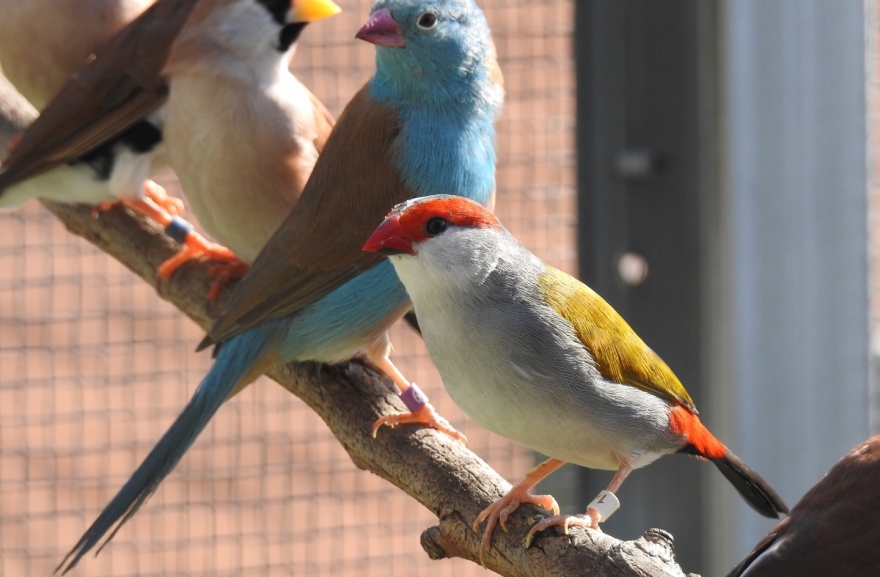A large aviary filled with dozens of different bird species living together in perfect harmony is the dream of many bird keepers. Unfortunately, getting lots of different species to live peacefully alongside each other can be a struggle. In this article, we look at a few aviary design ideas you can implement to keep fighting to a minimum.

Provide surplus nesting sites
In any aviary, there will always be a handful of nesting sites that are simply better than all the others. They might be closer to the livefood dish, receive the best morning sun, or just be in a spot that’s easier for a territorial species to defend.
Birds will squabble over the best locations, but there are some things you can do to keep the fighting to a minimum. The most important thing is to provide far more nesting sites than there are pairs of bird. At a minimum, 3 nesting locations should be offered for every 2 pairs of birds.
For parrots, make sure the nests are placed at about the same height throughout the aviary. If you’re keeping finches, offer wide variety of different types of nesting receptacles, including baskets, boxes, tunnels, and cups.
Nests should be placed as far apart as possible to limit aggression during the breeding season. Birds will often fiercely defend and area 1-3ft around the entrance to their nest. Make sure the protected area of one pair doesn’t intersect that of another pair, otherwise vicious fights will be inevitable.
Avoid problematic species
Not every species is suited to life in a mixed collection. As a general rule, parrots can’t be mixed with finches, except for a few limited exceptions.
Many of the really common birds found in pet stores are not suitable for mixing with other species. These include budgies and lovebirds, which can be incredibly vicious considering their compact size. Zebra finches are another common species that can cause quite a bit of trouble in a mixed collection.
Finchinfo has a great chart that highlights which finch species are compatible with each other. When in doubt, stick to the placid species or ask someone with more experience.
Making sure all species chosen for a mixed collection are roughly the same size is an easy way to nip many aggression issues in the bud.
Add visual barriers and hiding places
When a large number of birds are living together in fairly close proximity, it’s inevitable that fights will eventually occur.
Fights are rarely over and done with after a single bout. Often, one bird will continue to chase and harass the other bird over an extended period of time.
Aviaries should be designed so that birds have places they can hide from harassment. Brush, plants, and nest boxes can all be positioned to create secluded spots where a bird can hide until things calm down.
Aviaries with an unusual shape, or containing partial separators, have an advantage over traditional rectangular aviaries because the line of sight between different areas is obstructed.
Ensure all birds are paired

Offer multiple feeding stations
Food can be a contentious resource in a mixed collection. The aviary’s most assertive birds will often attempt to control the area around the feed station.
An easy way to deal with this issue is to have multiple feeding stations in the aviary. If the aviary isn’t large enough to have a few metres distance between food locations, dividing their food between several smaller bowls is a good substitute.
In a finch collection, the live food bowl is most likely to cause aggression between birds. It can take a finch a few seconds to eat a mealworm, during which time they’re prone to being mugged by other birds. In my aviaries, it’s the king quails that are most likely to rob a finch of its mealworm, so they’re now fed livefood in a separate area.
Avoid overcrowding
Aviaries with higher population densities almost always have more trouble with aggression. When forced to live in close proximity to other birds, competition over limited perches, nesting sites, nesting material, and food is heightened.
When birds are overcrowded, their stress levels go up and they react aggressively to even the most minor provocation.
There’s no exact number of birds that you can fit into a given sized aviary. With a mixed finch collection, I try to stick to one pair of birds for every two square metres of aviary space. If small parrots are involved, I go up to four square metres per pair.
Keep in mind that paired birds in an aviary will (hopefully) breed and produce even more birds. A productive breeding season can vastly increase the number of birds your aviary needs to hold, so if it’s already at capacity problems will ensue. Always stock aviaries sparsely in anticipation of young birds.
Young birds are especially vulnerable to aggression or stress related deaths. Where space is limited, young birds should be separated into their own aviary as soon as they’re fully independent from their parents.